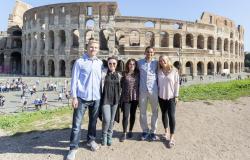The city of Rome has captured the imagination of the world for centuries. Fabled names such as Julius Caesar, Hadrian and Augustus conjure images of a time when Rome was not just a city, but the heart of an empire.
Archaeology tells us that the site has been inhabited by humans for more than 14,000 years, but it is generally agreed that it was not until the middle of the eighth century BCE that the city of Rome, as we know it, was founded.
Many theories have been offered as to why that particular site was chosen to build a city. Most recently it has been suggested that it was due the early Romans' necessity for salt. Indeed, the only salt-fields in western Italy lay at the mouth of the Tiber river and the discovery of a seventh century "salt road"(the Via Salaria) linking Rome and Ostia further reinforces this theory. But there is a far older “explanation”, one shrouded in legend and myth, stretching back as far as Rome itself: The legend of Romulus and Remus.
The ancient Greek historian Diocles has been credited with writing the first history of Rome, in the 3rd century BCE, and it is here that the legend is first recorded. Romulus and Remus were twin brothers. Their grandfather Numitor was the rightful king of Alba Longa, and is said to have been a descendant of the Trojan prince Aeneas. Before the conception of the twin boys, Numitor's brother, Amulus, deposed the King and killed his sons. He then forced Rhea, Numitor's daughter, to become a vestal virgin, intending to secure the throne for himself.

Against his wishes, Rhea conceived twin boys, Romulus and Remus, with the demi-god Hercules. When a furious Amulus found out, he took the boys from her and threw them into the Tiber river to drown. They were rescued by a she-wolf, who, according to the legend, took care of the infants by allowing the them to suckle her milk until they had regained their strength.
After leaving the she-wolf, Romulus and Remus found their way to the Shepherd Faustulus. Faustulus would raise the boys as his own: training them as shepherds until they had grown into two fine young men. It is said that it was during these years that they developed their natural ability for leadership: inspiring the men around them and showing the first sign of what would lie ahead.
After learning their true identities, they returned to Alba Longa, killed Amulus and returned Numitor to his rightful place as King. The twins then decided that it was time to found their own city.
The location would prove difficult, Romulus favored the Palatine hills, while Remus favored the Aventine hills. The only way to settle the debate, then, was to ask the gods for a sign. And so a sacred ground was laid between the two hills and the twins waited. Romulus claimed to have seen 12 eagles, but Remus claimed to have seen six long before Romulus had seen any, and thus believedthe sign was intended for him. In the quarrel that ensued, Remus was killed.
It is not clear how Remus exactly met his fate. Some sources say that he infuriated Romulus by criticizing his defensive wall so much that Romulus jumped over it and killed his brother shouting: "So perish anyone that shall hereafter jump over my wall", and in other versions, no explanation of his death is offered at all.
The regretful Romulus would name his new city after himself, and on April 21, 753 BCE, the city of Rome was born. He would honor his brother each year with a festival held on May 9, 11 and 13, in which evil spirits were vanquished by the head of each household by throwing black beans over their shoulder on the stroke of midnight.

Although Romulus now had his city, he still had no populous to live there. To solve this problem, he would invite bandits, outlaws and ex-slaves to populate his new city. But of course, no city can survive without women, and to solve this problem Romulus would need all his cunning. He decided to stage an elaborate festival to celebrate Consus: the God of grain. He invited all the inhabitants of the surrounding area and while the men were busy watching the games, the women were abducted: this became known as the “Ratto delle Sabine”, the rape of the Sabine women.
On hearing of this the Sabine King Tatius sent troops against Rome. The attack was repelled with the help of the god Juno , who favored Romulus. In time, peace was restored and the two kings, Tatius of Sabine and Romulus, ruled side by side until Tatius' death a short time later.
Romulus continued to reign until 717 BCE when at the age of 54, he died under mysterious circumstances. While he was inspecting troops at the campus Martius, he simply disappeared during a great storm. Poets of the day believe he was taken by the gods, but murder is a more likely explanation.
The city of Rome continued to flourish and remained at the heart of an empire that, at its height, cover more than 6.5million km of the earth's surface, stretching from Britain to Africa.
The legend of Romulus and Remus remains a classic Roman tale of regret, betrayal, strength and courage. The story continues to enchant people just as it did almost 2000 years ago. The image of Romulus and Remus as infants reaching up to suckle the milk of the she-wolf remains one of the enduring images of Rome. It can be seen in numerous places around the city and has famously been adopted by the city's football team, AS Roma, for their club crest.
We may never know the true origins of Rome. What we do know is that it is a city that has been shrouded in myth since the day it was born. And maybe this is part of the reason it continues to fascinate and intrigue people like no other city can. Romulus and Remus may be long gone, but their legend lives on and remains as important to Roman culture now as it did all those centuries ago.












